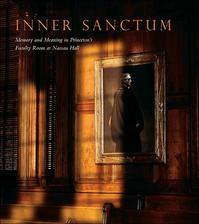A collection of essays examines the Faculty Room and its history
New book: Inner Sanctum: Memory and Meaning in Princeton’s Faculty Room at Nassau Hall, edited by Karl Kusserow (Princeton University Art Museum, distributed by Princeton University Press)
The editor: An associate curator of American art at the Princeton University Art Museum, Kusserow curated the museum’s exhibition, Inner Sanctum, located in the Faculty Room and open through Oct. 30. In conjunction with the show, he edited this book that, like the exhibit, explores the Faculty Room’s role as the symbolic center of the University, the history of the room itself, and how the space and the portraits reflect not only the evolution of the University and its history but also broader sociocultural trends.
The book: In addition to a chapter by Kusserow, the book includes essays by professor emerita Toni Morrison (a meditation on the “spirit of the place” and Princeton’s guiding principles), history professor Sean Wilentz (a history of Nassau Hall); professor of religion and African-American studies Eddie S. Glaude Jr. *97 (who reflects on the “historical wounds” of Faculty Room – a room filled with portraits of white males – and his own relationship with “an institution whose history necessarily excludes you”); and a poem by professor Paul Muldoon.
The opening lines of Kusserow’s chapter, “Memory and Meaning in the Faculty Room”: “Notable among the transactions at the December 18, 1849, meeting of the board of trustees of the College of New Jersey — or Princeton College, as it already was known — is an item resolving ‘that the Vice-President be requested to take measures to collect as many of the Portraits of the Officers and Trustees of the College, as can be obtained.’ In authorizing such an initiative, the century-old institution endorsed the creation of a durable and potent means of self-representation and signaled its continued vigor following periods of instability, stagnation, and outright decline.”












No responses yet